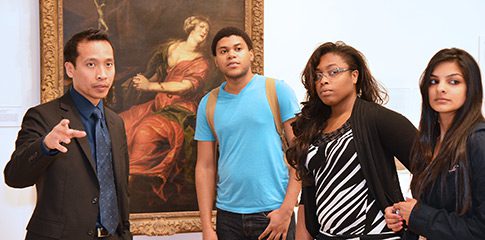Faculty Info
Name: Pablo P.L. Tinio
Title:Professor
Department: Elementary & Early Childhood Education
Degree(s): PhD, University of Vienna
Contact Information:
Office Powdermaker Hall 100
Phone: (718) 997-4913
Email: pablo.tinio@qc.cuny.edu
“One of the things I think about as an educator working with the arts, and interested in bringing arts to the classroom, is this idea of respecting children’s naïve response to art.”
– Pablo P.L. Tinio
Past Profiles

“Does listening to music make kids more attentive? Does participating in dance help them with their visual and spatial skills?” In citing those benefits of arts education, Pablo P.L. Tinio (Elementary & Early Childhood Education) agrees how important they are. “But I don’t think art should be secondary,” insists the cognitive/educational psychologist. “It is what it is, its own entity. Humans spend a great deal of time and money making or looking at art. It doesn’t make sense that it is itself of no value.” As the professor elegantly states, “Art should be the bride.”
Moving to New York at age 18, Tinio launched into college at Kean University as well as fashion/portrait/documentary photography and multimedia art. “The academic and the artistic always went hand in hand,” as he puts it. Then, instead of art’s bridegroom, he became a keen observer at the wedding, “more interested in how people experienced art, how they looked at the aesthetic side of it, rather than creating it.” In 2006, after earning master’s degrees in educational psychology at Rutgers and behavioral science at Kean, he moved to Austria to be a research scientist at one of the world’s center of aesthetics inquiry, the Department of Psychology at the University of Vienna, and earned his doctorate. His focal point became “the continuity between what the artist was feeling and thinking at the moment of creation, and whether that is being picked up by the perceiver of art.”
Tinio’s large kit of behavioral and psychophysiological tools distinguishes him from those using only one or two to analyze the factors contributing to an encounter with art, a field known as empirical aesthetics. To understand complex preferences in visual arts, how people learn about and engage with paintings and photographs, he enlists surveys, interviews, eye-tracking, controlled exposure, randomized studies, and other methods. “I create measures that really get to their emotions, really get to their self-reflections,” he notes. “It’s not just asking people what they think of a certain piece.” His many collaborations in the metro area and internationally include projects with the Whitney and Queens museums of art.
Born in the Philippines, the son of two teachers, Tinio grew up on Guam. Helping his mother in her elementary school classroom, he recalls, “I had chalk on my hands at all times.” In his chalk talks today, Tinio transforms lectures into interactive seminars: “I don’t think I ever speak of an abstract concept without making it concrete.” He had his Child Development students design toys geared to physical disabilities; their creative spins featured books, board games, and tops. His students’ diverse backgrounds “make it so much fun to teach at Queens College,” he has found since joining the faculty in 2010.
As a psychologist “working with the arts, and interested in bringing arts to the classroom,” Tinio believes in respecting children’s “naïve response to art.” Before a field trip to a museum—which he strongly encourages—he knows teachers may spend a week prepping their pupils. “That’s wonderful,” he says, “but it’s also a bad thing because we’re priming them to respond in a way we want them to respond.”
Encountering a visual artwork represents “a connection, as it is with most people, but with me it’s more explicit,” Tinio says. “How does it fit in with my experiences, my life? I love, love looking at artworks and paying attention to my feelings. I love artworks that kind of scare me, that throw me off.”
Themes from his dissertation—among them people’s preference for images of nature over human-made scenes, how we spend more time looking at faces if they are attractive, and how emotion modulates the brain’s affinity for curved objects—continue to intrigue him. Tinio also is curious about how the first-hand emotional experience compares with the second-hand (such as viewing a painting vs. a digital image), and whether pixel quality affects the pleasure of perception. “There is something to be said for the scale of things, to going to an Imax theater and feeling the rumble in your stomach, the visceral experience of art,” he believes.
Among his scholarly works, Tinio has written numerous peer-reviewed articles, contributed to The Neuroscience of Creativity, and just completed another book. Recently, he was named co-editor of the journal The Psychology of Aesthetics, Creativity and the Arts. In an interview in the American Psychological Association’s Monitor on Psychology (January 2012), he mentioned how his frequent talks with art historians, curators, and artists have demonstrated their interest “in what scientists have to say about the experience of art.”
He happily obliges. “Art is one of the most puzzling things in the world, in our lives,” Tinio reflects. “It’s such a dominant aspect in terms of it being everywhere, in everything we do—movies, posters, music while we’re driving. It’s a great challenge to be working with such a grand question.”
Favorite artists: Abstract Expressionists—Willem de Kooning and Barnett Newman among them—fire his neurons for “the concept behind” their squiggles and drips, color blocks and lines.
Surprising fact: Delights in bread-baking, rock climbing, mountaineering, winter backpacking, and “living in nature with only a few tools.”
Recommended book: Eric Kandel’s The Age of Insight: The Quest to Understand the Unconscious in Art, Mind and Brain, centering on Vienna.

